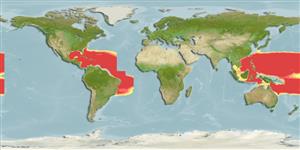>
Trachichthyiformes (Roughies) >
Anoplogastridae (Fangtooths)
Etymology: Anoplogaster: Greek, ana = up + Greek, oplon = shield + Greek, gaster = stomach (Ref. 45335); brachycera: From the main characters of the young specimens which have short temporal and pre-opercular spines.
Environment: milieu / climate zone / depth range / distribution range
Écologie
marin bathypélagique; profondeur 0 - 1500 m (Ref. 31253). Deep-water
Pacific and Atlantic: tropical waters, from the Sulu Sea in the western Pacific and from the Gulf of Mexico to north of the Bahamas Islands in the western Atlantic (Ref. 50735); off southeastern USA (Moore, pers. comm.).
Taille / Poids / Âge
Maturity: Lm ? range ? - ? cm
Max length : 6.0 cm SL mâle / non sexé; (Ref. 31253)
Minimum depth from Ref. 58018.
Life cycle and mating behavior
Maturité | Reproduction | Frai | Œufs | Fécondité | Larves
Paxton, J.R., 1999. Order Beryciformes. Anoplogastridae. Fangtooths. p. 2210. In K.E. Carpenter and V.H. Niem (eds.) FAO species identification guide for fishery purposes. The living marine resources of the WCP. Vol. 4. Bony fishes part 2 (Mugilidae to Carangidae). FAO, Rome. (Ref. 9852)
Statut dans la liste rouge de l'IUCN (Ref. 130435: Version 2024-1)
Menace pour l'homme
Harmless
Utilisations par l'homme
Pêcheries: sans intérêt
Outils
Articles particuliers
Télécharger en XML
Sources Internet
Estimates based on models
Preferred temperature (Ref.
123201): 7.2 - 18.9, mean 11.1 °C (based on 563 cells).
Phylogenetic diversity index (Ref.
82804): PD
50 = 1.0000 [Uniqueness, from 0.5 = low to 2.0 = high].
Bayesian length-weight: a=0.01995 (0.00906 - 0.04395), b=3.01 (2.83 - 3.19), in cm total length, based on all LWR estimates for this body shape (Ref.
93245).
Niveau trophique (Ref.
69278): 3.3 ±0.5 se; based on size and trophs of closest relatives
Fishing Vulnerability (Ref.
59153): Low vulnerability (10 of 100).
